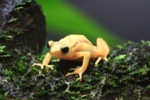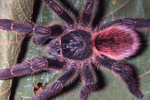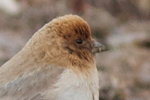
Various reconstructions of Lucihormetica luckae. Images courtesy of Vršanský et al.
While new species are discovered every day, Peter Vršanský and company’s discovery of a light-producing cockroach, Lucihormetica luckae, in Ecuador is remarkable for many reasons, not the least that it may already be extinct.
The new species represents the only known case of mimicry by bioluminescence in a land animal. Like a venomless king snake beating its tail to copy the unmistakable warning of a rattlesnake, Lucihormetica luckae’s bioluminescent patterns are nearly identical to the poisonous click beetle, with which it shares (or shared) its habitat.
Most common in the deep sea where it first evolved, bioluminescence is the chemical reactions that give certain organisms the ability to produce light. Other luminescing species use light to communicate, attract mates or evade predators, as well as illuminate their environment.
 The possibly extinct Lucihormetica luckae, which oddly resembles a Jawa from Star Wars. Photo courtesy of Vršanský et al. |
According to the research published in the journal Naturwissenschaften, Lucihormetica luckae is the first known case of asymmetrical bioluminescence. It sports two eye-like spots on its upper back and a tiny third one on the right side only. These lanterns are covered over by a reflective surface similar to an automobile headlight, Vršanský told mongabay.com. This allows the insect to conceal itself behind its own brightness.
Nearly as soon as this species became known to science, it may have been extinguished by the eruption of the Tungurahua Volcano, where it lived. Though the paper documenting their discovery was only published this July, no specimens have been found since the eruption in 2010.
Vršanský, who was first inspired by the beauty of Poloniny National Park, straddling the borders of Ukraine, Poland and Slovakia, and went on to do research on the effects of streetlights on pond ecology, believes his research shows that even creatures considered as terrible as cockroaches “are beautiful if you are sensitive enough.”

Tungurahua Volcano as seen by Google Earth.
CITATION: Vršanský, P., & Chorvát, D. (2012). light-mimicking cockroaches indicate tertiary origin of recent terrestrial luminescence. Naturwissenschaften, 99(9), 739-749.
Related articles
Whale only known from bones washes up on beach in New Zealand

(11/05/2012) In 2010, a whale mother and male calf were found dead on Opape Beach in New Zealand. Although clearly in the beaked whale family—the most mysterious marine mammal family—scientists thought the pair were relatively well-known Gray’s beaked whales (Mesoplodon grayi). That is until DNA findings told a shocking story: the mother and calf were actually spade-toothed beaked whales (Mesoplodon traversii), a species no one had ever seen before as anything more than a pile of bones.
Artificial ‘misting system’ allows vanished toad to be released back into the wild

(11/01/2012) In 1996 scientists discovered a new species of dwarf toad: the Kihansi spray toad (Nectophrynoides asperginis). Although surviving on only two hectares near the Kihansi Gorge in Tanzania, the toads proved populous: around 17,000 individuals crowded the smallest known habitat of any vertebrate, living happily off the moist micro-habitat created by spray from adjacent waterfalls. Eight years later and the Kihansi spray toad was gone. Disease combined with the construction of a hydroelectric dam ended the toads’ limited, but fecund, reign.
Happy Halloween: nine new species of tree-climbing tarantula discovered

(10/31/2012) If you suffer from acute arachnophobia, this is the perfect Halloween discovery for you: a spider expert has discovered nine new species of arboreal (tree-dwelling) tarantulas in the Brazil. Although tarantula diversity is highest in the Amazon rainforest, the new species are all found in lesser-known Brazilian ecosystems like the Atlantic Forest, of which less than 7 percent remains, and the cerrado, a massive savannah that is being rapidly lost to agriculture and cattle ranching.
Photo: high-altitude bird rediscovered after 80 years

(10/29/2012) In 1929 the U.S. Stock Market collapsed, the Geneva Convention set standards for prisoners of war, the first Academy Awards was celebrated, and Jérôme Alexander Sillem collected two bird specimens on a high plateau in Xinjiang, China. For 62 years, the specimens sat in a drawer at the Zoological Museum of Amsterdam until C. S. Roselaar found them, studied them, and determined they, in fact, represented a new species of bird: Sillem’s mountain finch (Leucosticte sillemi). Now, 83 years after Sillem collected the only known specimens, a French photographer, Yann Muzika, unwittingly took photographic proof that the finch species still survives.
After seven year search, scientists film cryptic predator in Minas Gerais
(10/25/2012) South America’s rare and little-known bush dog (Speothos venaticus) looks like a miniature dachshund who went bad: leaner, meaner, and not one to cuddle on your lap, the bush dog is found in 11 South American countries, but scientists believe it’s rare in all of its habitats, which include the Amazon, the Pantanal wetlands, and the cerrado savannah. Given its scarcity, little is known about its wanderings.
Picture of the day: a bizarre baby bird with oral ‘fingerprints’
(10/25/2012) The crested coua (Coua cristata) is native to island of Madagascar. Unlike much of Madagascar’s wildlife, the crested coua is not considered threatened with extinction, but is listed as Least Concern by the IUCN Red List. There are around nine species of coua in the world, all found in Madagascar; the unique birds belong to the cuckoo family.
By imitating human voices, beluga whale may have been attempting to communicate
(10/23/2012) Five years after the death of a captive beluga whale named NOC, researchers have discovered that the marine mammal may have been trying to communicate with people by mimicking humans voices at the National Marine Mammal Foundation in San Diego. Analyzing tapes of human-like speech from the young male beluga whale, scientists writing in Current Biology note that while there have been reports of beluga whales making human like sounds before, this is the first time evidence has been captured on tape and analyzed.
Picture of the day: the maned lioness
(10/15/2012) The title is not a typo. Sometimes lioness grow manes as rich and large as males, and there appears to be larger proportion of such ‘maned lionesses’ in Botswana’s Okavango Delta.
Endangered turtle urinates through its mouth
(10/11/2012) One of China’s most commonly farmed turtles for consumption, the Chinese soft-shelled turtle (Pelodiscus sinensis), has a unique ability: it urinates out of its mouth. Researchers in Singapore, writing in The Journal of Experimental Biology, have discovered that the Chinese soft-shelled turtle excretes most of its urine from its mouth instead of its kidneys. They hypothesize that the turtle developed this ability in order to survive in brackish waters, which contain considerably more salt than freshwater.
Brainless slime mold uses slimy memory to navigate
(10/08/2012) How do you navigate space efficiently without a brain? Slime, according to a surprising new study in the Proceedings of the National Academy of Sciences (PNAS) of a brainless slime mold named Physarum polycephalum. Scientists at the University of Sydney have discovered that the mold secretes slime as an ‘external spatial memory’ to make sure it doesn’t end up going around in circles.